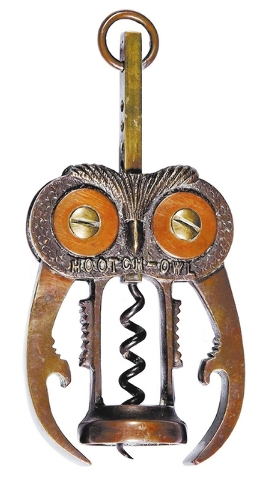Prices on the rise for old, unusual corkscrews

Wine spoils quickly if exposed to the air. It was not until the 18th century that glassblowers were able to make bottles with narrow necks that made airtight storage possible.
The best seal for the bottle was a cork, and when the English began to bottle wine in the 1700s they also invented a corkscrew to open the bottle. At first, corks were removed with an existing tool used to clean muskets. But soon other types of openers were invented.
Early corkscrews were usually T-shaped devices that pulled the cork. It is said that the first patented corkscrews were made in England in 1795, France in 1828 and the United States in 1860.
There are many types of corkscrews. The single-lever corkscrew and the double-winged-lever corkscrew, patented in 1930, both screwed into the cork. Raising and lowering the lever removed the cork.
Hundreds of other clever designs can be found, so collecting is a challenge. By the 1970s, collectors could find books and clubs for corkscrew enthusiasts. A corkscrew collector is called a “helixophile.”
Prices have been going up during the past 20 years as the supply of old, unusual corkscrews gets smaller and interest grows in wine and its necessary accessories. A figural brass corkscrew named “Hootch-Owl,” patented in 1936, sold for $1,725 in February 2014 at a Jeffrey S. Evans auction.
Q: I have a Roy Rogers and Dale Evans Double R Bar Ranch metal lunch box that pictures Roy on Trigger, Dale Evans waving her hat in greeting, and their dog, Bullet, running alongside. The back and sides look like wood grain and there is a “brand” on the back. Can you tell me when it was made and what it’s worth?
A: Your lunch box was made by the American Thermos Co. in 1953. A nearly identical box with blue or red sides and a wood grain back was made in 1954. It came with a matching thermos. It was the first completely lithographed steel lunch box made.
The lunch box with thermos sells for $75 to $100 today; the lunch box alone for $50 to $80.
Q: I am stumped by a piece of wooden furniture I inherited. It looks like a three-drawer dresser, but the dresser’s top and the hinged front of the top drawer lift up to reveal a trouser press next to a small storage bin. And the bottom drawer front opens on hinges, too.
The only mark I can find is “Pat. No. 112843.” It’s impressed on both the press and the back of the dresser. The press can be unscrewed from the dresser. Can you tell me who made it, how old it is and what it’s worth?
A: The patent number refers to a British patent, not an American one. The patent application was filed in England in 1917 by Frank Henry Miles, a “cabinet manufacturer, Crown Cabinet Works, Redcross Street, Bristol.”
The patent was granted on Jan. 31, 1918. It relates to Miles’s invention of a “trouser press and cabinet combined.” The patent application states that the press could be “adapted to any piece of furniture as desired or if required made as a separate press.”
It is likely that your combination trouser press-dresser dates from the late 1910s or early 1920s. The storage bin was meant to be used for “small wearing apparel” (such as collars, etc.). As a piece of furniture, your press-dresser might sell for $200 to $300.
Terry Kovel’s column is syndicated by King Features. Write to: Kovels, (Las Vegas Review-Journal), King Features Syndicate, 300 W. 57th St., New York, NY 10019.